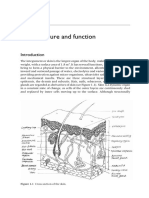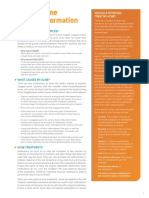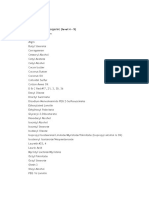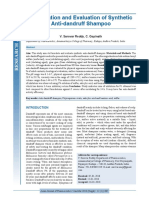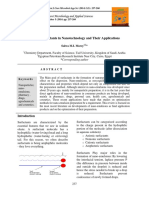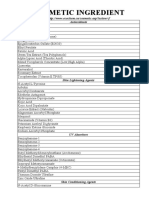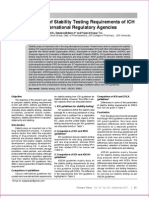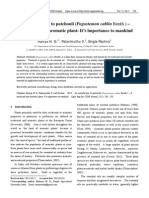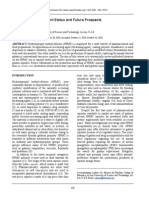Shampoos 1
Shampoos 1
Uploaded by
kunalprabhu148Copyright:
Available Formats
Shampoos 1
Shampoos 1
Uploaded by
kunalprabhu148Copyright
Available Formats
Share this document
Did you find this document useful?
Is this content inappropriate?
Copyright:
Available Formats
Shampoos 1
Shampoos 1
Uploaded by
kunalprabhu148Copyright:
Available Formats
356
Review Article
DOI: 10.1111/j.1610-0387.2007.06304.x
Shampoos: Ingredients, efficacy and adverse effects
Ralph M. Treb
Clinic for Dermatology, University Hospital of Zurich, Switzerland
JDDG; 2007 5:356365
Submitted: 5.10.2006 | Accepted: 18.12.2006
Keywords
shampoo technology Surfactants hair conditioning dandruff Malassezia anti-dandruff shampoo
Summary
Shampoos are the most frequently prescribed treatment for the hair and scalp. The different qualities demanded from a shampoo go beyond cleansing. A cosmetic benefit is expected, and the shampoo has to be tailored to variations associated with hair quality, age, hair care habits, and specific problems related to the condition of the scalp. The reciprocal relationship between cosmetic technology and medical therapy is reflected in the advances of shampoo formulation that has made applications possible that combine benefits of cosmetic hair care products with efficacy of medicinal products. A shampoo is composed of 10 to 30 ingredients: cleansing agents (surfactants), conditioning agents, special care ingredients, and additives. Since the cleansing activity depends on the type and amount of surfactants utilized, shampoos are composed of a blend of different surfactants, depending on the requirements of the individual hair type. Development time from the concept to the commercial shampoo may take longer than a year. Much effort is invested in the development of conditioning agents, which impart luster, smoothness, volume and buoyancy. Another prerequisite is a scalp free of scaling. Current anti-dandruff agents primarily have an antimicrobial mode of action, and inhibit growth of Malassezia spp. Recent developments in shampoo technology have led to increased efficacy of anti-dandruff agents, allowing shorter contact time, and reducing irritation.
Introduction Shampoo treatments are the most commonly used means of managing hair and scalp conditions. Until the introduction of the first non-alkaline shampoos in 1933, soap was the only available cleanser for the hair [1]. Modern shampoos are expected to be much more than mere cleansing agents. They are expected to not dry out the hair; to produce lather in hard and soft water and when applied to oily hair; to be non-irritating to skin and mucous membranes; to be chemically and physically stable; to possess conditioning benefits; to be biodegradable; and affordable. A shampoo is ex-
pected to improve the hair cosmetically while being tailored to the needs of various hair types as well as age and individual habits; at the same time it should have a positive effect on specific problems involving the hair and scalp [2]. Shampoos have thus evolved into hightech products consisting of 10 to 30 ingredients [35] (Figure 1) that are combined in precise formulations to meet consumer demands. Ingredients include: Detergents, i.e., surfactants Conditioning and active ingredients for hair manageability Additives that modify the surfactant effect (viscosity control agents, foam
stabilizers), stabilize the product (preservatives), and increase its appeal (fragrances, dyes, and ingredients for consistency and a pearlescent appearance). It can take more than a year from the initial planning phase to a saleable product. More effort is being invested in conditioners which are designed to give the hair a more healthy appearance, making it shiny and smooth while increasing volume and resilience. Scalp condition is another important factor in individual health and well-being; the scalp should neither be oily nor should dandruff develop.
JDDG | 52007 (Band 5)
The Author Journal compilation Blackwell Verlag, Berlin JDDG 1610-0379/2007/0505-0356
Shampoos: Ingredients, Efficacy and Adverse Effects
Review Article
357
Shampoo ingredients
Surfactants
Conditioners
Active ingredien
Hair cleansing Anionic surfactant Amphoteric surfactant
Hair treatment
Protein hydrolysates Guar hydroxypropyltrimonium chloride Cationic substances (e.g., Polyquaternium-10) Silicones (Dimethicone) Plant extracts Special ingredients , e.g., anti-dandruff : Selenium disulfide, Zinc pyrithione, Piroctone olamine Ciclopirox olamine, Ketoconazole
+ Additives
Modification of Surfactant effect
Product stabilization
Product appeal
Nonionic surfactants Preservatives Menthol Moisturizers (e.g., parabens) Perfume oils (e.g., alkanolamides, Chelators Dyes natural oils) (EDTA) Liquid crystal concentrate humectant UV absorbers (propylene glycol, Antioxidants polyethylene glycol, Buffers (e.g., sodium citrate) glycerin, sorbitol) Dispersing agents Viscosity control agents Co-solvents (Polyacrylate)
Figure 1: Shampoo ingredients.
The most important effects of shampoo on the hair are: moisturizing adsorption and/or penetration of the hair cleansing, removal of oils, lipid regeneration. The following effects of shampoo influence scalp condition: restoration of alkali neutralization ability (pH) dryness seborrhea scalp bacteria (Malassezia spp., Propionibacterium spp.) enzyme activity of the scalp scalp circulation Shampoo surfactants The cleansing ability of a shampoo depends on the surface activity of its detergents. Surface-active ingredients, or surfactants, facilitate the removal of environmental dirt by reducing surface tension between water and dirt; dirt is suspended in the water phase and adsorption prevented. This is achieved by a special molecular structure consisting of
a hydrophilic and a lipophilic group. Sebum and dirt are bound and surrounded at the center of a micelle structure with the hydrophilic molecule ends pointing outward. Dirt particles become watersoluble and can be removed from the hair shaft [3]. Surfactants are classified according to hydrophilic polar group as anionic, cationic, amphoteric (zwitterionic) and nonionic [3]. The cleansing ability of a shampoo depends on how well it removes grease as well as the type and amount of surfactants used. Various surfactants are used in shampoos in order to accommodate different hair types. In most products, the shampoo base consists of anionic and amphoteric surfactants. Depending on individual product requirements, nonionic and cationic surfactants are added to modify the effects of the surfactants or as conditioning agents for hair with surface damage [3]. Anionic surfactants Anionic surfactants are characterized by a negatively-charged hydrophilic polar
group. Well into the 20th century, natural soaps were the most commonly used anionic hair cleansing substances. Soap consists of salts that are extracted from naturally-occurring animal or vegetable fatty acids. Synthetic surfactants have now replaced soap as a hair cleanser. Because soap is sensitive to hard water, it leaves insoluble salts on the hair, forming a film which causes a dull look. Soaps alkaline pH can make it irritating to the skin and mucous membranes. The first shampoos introduced on the market in 1933 were alkyl sulfate surfactants [1]. These were still sensitive to hard water and were not adequately tolerated by the skin. They have since been replaced by sodium alkyl ether sulfates which are now the leading surfactants. These are superior with regard to sensitivity to water hardness as well as skin and mucous membrane tolerability and are virtually the only surfactants that are can also be used alone in a shampoo as raw ingredients. The best known anionic surfactants are sulfated fatty alcohols, alkyl sulfates, and their polyethoxylated analogues, alkyl
JDDG | 52007 (Band 5)
358
Review Article
Shampoos: Ingredients, Efficacy and Adverse Effects
ether sulfates. They possess an outstanding cleansing ability and produce rich lather. A number of anionic surfactants such as alkyl ether carboxylate, acyl peptides, alkyl sulfosuccinate, and olefin sulfonate, which are well tolerated by the skin, and are used together with other anionic and amphoteric surfactants to optimize shampoo properties [3]. Amphoteric surfactants Amphoteric (zwitterionic) surfactants contain both negatively and positively charged hydrophilic polar groups. At low pH values they behave as cationic agents and at higher pH values as anionic agents, and are thus classified between cationic and anionic surfactants. Amphoteric surfactants form complexes with anionic surfactants and reduce their tendency to attach to proteins. In combination with anionic surfactants, amphoteric surfactants are mainly used to optimize anionic-based shampoos: amphoteric acetates/diacetates in particular demonstrate excellent skin and mucous membrane tolerability, have a conditioning benefit on the hair, and are suitable for use in mild shampoos [3]. Examples include betaine, sulfonate betaine, amphoteric acetate/diacetate. Nonionic surfactants Nonionic surfactants differ from other surfactants in that they do not possess a charged polar group and are hence compatible with all other surfactants. They are also among the mildest form of surfactant; they make good cleansers with dispersion and emulsification properties, but lather poorly. In combination with alkyl ether sulfates or amphoteric surfactants, they serve to enhance tolerability in very mild cleansers such as baby shampoos [3]. Examples of nonionic surfactants are fatty alcohol ethoxylates, sorbitan ether esters, and alkyl polyglucosides. Cationic surfactants Cationic surfactants are quaternary ammonium compounds which are characterized by a positively-charged hydrophilic polar group. Given its amino acid structure, the keratin found in human hair has an excess of negatively-charged acid groups. The positively-charged quaternary ammonium compounds of cationic surfactants thus attach by salt bonds to the negatively-
charged hair and remain after rinsing. Due to its high level of cysteine, damaged hair contains a higher number of negativelycharged acid groups and thus absorbs more quaternary ammonium compounds than intact hair [3]. Because of this quality, quaternary ammonium compounds are used as conditioning agents for damaged hair. Although they make hair easier to comb and manage, and they have anti-static properties, they are poor cleansers and do not lather well. They are also potentially strong irritants, and are thus only used with less irritating nonionic surfactants in shampoos designed for chemically-treated or very dry hair. Their incompatibility with anionic surfactants limits their use in other shampoo formulations [3]. Additives Shampoo products are also expected to possess stability and to have an appealing quality, making the use of a number of additives necessary. Modification of surfactant effects In addition to selection and combination of surfactants, additives also help reduce skin irritation. Moisturizers and humectant, for instance, are added to make the hair silkier. Moisturizers include natural oils, fatty acid esters, and alkanolamides; humectant include propylene glycol, polyethylene glycol, glycerin, sorbitol, and lactate [3]. Shampoo stabilization Ensuring shampoo stability requires the use of preservatives to protect against bacterial contamination (organic acids and their derivatives, e.g., parahydroxybenzoic acid ester, salicylic and sorbic acid; methylparaben; formaldehyde releasers, e.g., DMDM hydantoin); UV absorbers to stabilize dyes against light (benzophenone derivatives); antioxidants to protect oxidation-sensitive substances (ascorbic acid, -tocopherol, butyl hydroxyanisole); buffers to ensure pH stability (citrate, lactate, and phosphate buffers); co-solvents to keep conditioning oils and fragrances clear in solution; and dispersing agents to keep otherwise insoluble agents, such as silicone oils and anti-dandruff agents, in suspension (polyvinylpyrrolidone) [3]. Enhancement of product appeal The attractiveness of a shampoo is enhanced by fragrances, dyes, and special
ingredients that give it a pearlescent appearance. Fragrance oils cover up the typically fatty odor of the shampoo base and lend the product and individual, pleasant-smelling scent. An appealing fragrance also helps promote regular use of the product. Dyes and liquid crystal concentrates give the shampoo a pearlescent and more concentrated appearance. Liquid crystal concentrates also contribute to its moisturizing effect. They usually consist of insoluble crystal particles made up of fatty acid esters of polyols and alkanolamide derivatives of fatty acids that reflect light [3]. Conditioners Depending on hair length and exogenous factors, the distal end of the continually growing hair shaft exhibits increasing signs of damage that can involve cuticle damage and secondary destruction of the cortex (Figure 2ac) [6]. Damage is mainly due to mechanical stresses caused by combing, brushing and teasing as well as the effects of UV rays and unavoidable structural alterations arising from chemical treatments such as permanent hair waving and coloring [6]. Along with ultrastructural changes to the hair shaft, there are measurable changes in biophysical parameters of the hair fibers, e.g., tensile-stretch properties and durability, as well as depletion of specific amino acids in the hair shaft, specifically, methionine (50 %), tryptophan (50 %), cystine (20 %), histidine (20 %), tyrosine (10 %) and lysine (10 %) [7]. The aim of conditioning agents in a shampoo is to maintain the natural condition of newly grown hairs for as long as possible. Virtually all standard shampoos used today contain conditioning agents. Damaged hair can, of course, not be restored to the condition of healthy, newly growing hair, and more than a reparative effect cannot be expected. Nonetheless, it is possible to increase shine and make hair more manageable and easier to comb by using a shampoo with a high proportion of conditioning agents, i.e., the conditioner effect [3, 4]. Conditioning agents include fatty substances such as vegetable oils, wax, lecithin and lanolin derivatives, protein hydrolysates (collagen, silk, animal proteins), quaternary ammonium compounds and silicones. There is increasing use of cationic polymers in place of
JDDG | 52007 (Band 5)
Shampoos: Ingredients, Efficacy and Adverse Effects
Review Article
359
monomer quaternary ammonium compounds, in which the cationic groups are integrated in a polymer structure, e.g., polyquaternium-10 and polyquaternium16 as well as guar hydroxypropyltrimonium chloride [3]. These adhere more firmly to the hair than monomer bonds and leave a film that coats the surface of the hair fiber, making it appear to be soft and smooth while improving shine and color by altering the refractive index. In addition to their use in conditioners, these cationic polymer finishing agents have become a main component of 2-in-1 shampoos which combine cleansing and conditioning [8]. The amount used must correspond to the condition of the hair since these agents have a high affinity for the hair and with repeated use can build up on the hair shaft. Excessive conditioning can make hair less manageable and appear oily [3, 4]. In addition to cationic polymer finishing agents, silicones are also used, especially dimethicone, which is added along with special dispersing agents to a shampoo base containing a relatively high proportion of surfactants [4]. The strong conditioning effect occurs as a result of extremely fine dimethicone droplets being deposited on the hair as the shampoo is diluted during washing. Silicone has a similar effect to that of fats and oils, but without weighing the hair down. Silicones add lubricity and reduce friction that arises from combing, making the hair easier to comb and style, and thus also preventing damage. They also give the hair anti-static properties that prevent it from becoming frizzy. Active ingredients Active ingredients are added to shampoos for the management of specific problems affecting the scalp such as mild dandruff, seborrhea, seborrheic dermatitis, and psoriasis [5]. The spectrum of active ingredients is broad and encompasses various classes of substances, depending on indications for use; newer, scientifically proven anti-dandruff ingredients including selenium disulfide, zinc pyrithione [9], piroctone olamine [10], ketoconazole [11, 12], and ciclopirox olamine [13, 14] are used alongside traditionally-used substances derived from natural sources, e.g., plant extracts. Anti-dandruff shampoos One study with 1 000 men reported that 18 % of respondents had mild dandruff
c
Figure 2: Raised hair cuticle (a), complete loss of hair cuticle (b), loosening of intercellular cement with initial transverse fracture in the fiber (c). From: Treb R M. Haare. Praxis der Trichologie. Steinkopff, Darmstadt, 2003.
JDDG | 52007 (Band 5)
360
Review Article
Shampoos: Ingredients, Efficacy and Adverse Effects
Figure 3: Pathogenesis of dandruff.
and 4.5 % severe dandruff [15]. In a smaller study with 500 students, 70 % reported having dandruff [16]. Specific anatomic features of the scalp skin, such as the large number of terminal hair follicles and the enlarged epidermal surface due to numerous hair canals, contribute to a higher rate of exfoliation; even a healthy scalp will develop dandruff within one or two weeks if the hair is not washed. Pathological dandruff results from accelerated proliferation of epidermal cells and thus increased exfoliation of variously large collections of abnormally keratinizing epidermal cells [17]. This leads to breakdown of the normal columnar structure of the stratum corneum [18] and increased formation of cell aggregates which determine the size of the flakes. The process results from focal inflammation of the scalp with parakeratosis which causes abnormal exfoliation and an altered light
refractive index of the keratinized cell aggregates (Figure 3). The clinical appearance of dandruff is determined by the size, adherence, and light refractive characteristics of the flakes. Among the factors that lead to inflamed patches on the scalp are physical/chemical stimuli, microbial colonization, and sebum production and composition. The lipophilic yeast Malassezia spp. normally inhabits the scalp, making up about 45 % of its resident microflora. In patients with dandruff, it is the predominant yeast type with about 75 % and in patients with seborrheic eczema 83 % [19]. Modern classification and nomenclature of Malassezia spp. is based on DNA typing. The most common types found on the scalp are M. restricta and M. globosa, the latter of which in particular has a major role in the development of dandruff given its high level of lipase activity.
Dandruff can be divided by clinical appearance into simple dandruff (Pityriasis simplex), oily dandruff (Pityriasis steatoides), and asbestos-like scales (Pityriasis amiantacea) (Figure 4ac). Pityriasis simplex [20] typically occurs with dry skin as a result of atopic dermatitis or age-related dry skin. It can be caused by excessive hair-cleansing or the use of a shampoo designed for oily hair. Typical findings include dry, bran-like scales, and patients often complain of itching. Most authors cite the co-existence of overgrowth of Malassezia spp. in pityriasis simplex as evidence of its role in pathogenesis [21]. Pityriasis steatoides is associated with seborrhea of the scalp. It often occurs with inadequate personal hygiene and Malassezia spp. is widely believed to be involved in pathogenesis [22]. Firmly adherent, oily, bran-like scales are found,
JDDG | 52007 (Band 5)
Shampoos: Ingredients, Efficacy and Adverse Effects
Review Article
361
cosmetic shampoos) and ammonium bituminosulfonate (pale sulfonated shale oil as a coal tar substitute); keratolytic agents that break down cell aggregations, e.g., colloidal sulfur and salicylic acids [25]; antimicrobial agents that inhibit Malassezia spp. yeasts [26], e.g., selenium disulfide, zinc pyrithione, piroctone olamine, ketoconazole, and ciclopirox olamine; combinations of these substances. Zinc pyrithione demonstrates a strong anti-dandruff effect with a low potential for irritation or sensitization. Clinical studies have shown it to be superior to coal tar, selenium disulfide, and piroctone olamine. In one study the effect of 2 % b a ketoconazole was better and longer-lasting than 1 % zinc pyrithione [27], but improving shampoo formulation can increase the effectiveness of anti-dandruff agents [28]. In particular, the effectiveness of zinc pyrithione could be significantly improved with the use of micronized ingredients, especially given the legal maximum of 1 %. The zinc pyrithione molecule is present as a crystalline suspension in glycol distearate and is not water soluble. The formulation allows even distribution of zinc pyrithione crystals in shampoo and the use of non-spherical crystals measuring only 2.5 m allows better adsorption and more even distribution on the scalp. This is particularly effective in inhibiting Malassezia spp. yeasts, even with a short contact time and rinsing. The c combination of zinc pyrithione with zinc carbonate leads to reduced dissociFigure 4: Pityriasis simplex (a), Pityriasis steatoides (b), Pityriasis amiantacea (c). From: Treb R M. ation of the active ingredients into zinc Haare. Praxis der Trichologie. Steinkopff, Darmstadt, 2003. and pyrithione, which alone have a lower anti-dandruff effect [2931]. often on the anterior hairline, external crobial colonization, and psychological In scalp disorders that involve scaling, esear, preauricular area, and around the stress with lowered immune resistance. Medicated shampoos containing anti- pecially scalp psoriasis, the use of a medeyes. Pityriasis amiantacea [23] frequently oc- dandruff ingredients are essential in treat- icated shampoo is a valuable supplement curs as an idiopathic disorder in girls, but ing dandruff and exfoliative scalp disor- to topical corticosteroid therapy. 0.05 % can also be related to lacking personal ders such as seborrheic eczema and clobetasol propionate has recently behygiene. It presents with well-circum- psoriasis. The choice and frequency of come available in short-contact shampoo scribed areas of thick, asbestos-like, shampooing are determined by the un- formulations for scalp psoriasis [32]. It firmly-attached scales with focal hair loss derlying cause, i.e., dry skin or seborrhea. presents a superior alternative to coal tar and no itching. Concomitant postauric- Patients with dry skin should be advised shampoo in terms of efficacy and prodto wash their hair less frequently and uct appeal [33] and results have shown ular skin cracks are typical. Specific dermatological disease such as avoid using oily hair shampoos; for pityr- that it does not produce unwanted cortieczema, psoriasis, tinea capitis, and pem- iasis steatoides, on the contrary, daily hair costeroid effects on the skin, adrenal phigus foliaceus should be excluded and cleansing alone can lead to improvement. axis, or eyes [34]. other pathogenetic factors should be The following agents are used in the considered and appropriately addressed treatment of dandruff: Medicated shampoos for managing in the treatment plan. These include agents that inhibit overproduction of seborrhea dermatitis of the scalp keratinizing cells, e.g., coal tar [24] A significant improvement in seborrhea physical/chemical environmental influ(now banned in Germany for use in generally cannot be achieved with overences, abnormal sebum production, mi-
JDDG | 52007 (Band 5)
362
Review Article
Shampoos: Ingredients, Efficacy and Adverse Effects
the-counter shampoos. Coal tar, which reduces sebum production, is virtually the only effective active ingredient in medicated shampoos [35]. Ammonium bituminosulfonate (ichthammol) is comparatively ineffective. Other options include a reduction in lipids and microbial lipolysis. To maintain volume, the surface of the hair must be prevented from becoming too smooth and to avoid lipolytic or peroxidative transformation of scalp or hair lipids, antimicrobial substances are used. This is usually achieved with a mild, generally anionic surfactant base consisting of effective cleansing substances with low substantivity [3]. Inhibition of microbial lipolysis can also be achieved by the surfactants forming the shampoo base. Antimicrobial agents that are effective against Malassezia spp. are suited for use in seborrhea and dandruff. Selenium disulfide is contraindicated since it increases sebaceous gland excretion [36]. Additional conditioners, especially moisturizers and cationic polymers, should be avoided in hair that has a tendency to become oily, since they weigh it down. The use of plant extracts containing tannin, e.g., oak bark extract, can have a positive influence holding a style by roughening the surface of the hair. Anti-aging shampoos As hair ages changes affecting pigmentation and growth become evident. Preventive measures begin with early avoidance of factors that cause damage to the hair and scalp such as UV rays [37, 38], tobacco smoking [39, 40], poor diet, and stress. UV rays contribute significantly to the aging of the skin and presumably the hair as well. The effect of UV radiation on the hair follicles is attributed, among other things to the light activation of porphyrins produced by Propionibacterium spp. in the hair canal which triggers a follicular microinflammation [41]. For this reason, the use of an antimicrobial solution is recommended as a preventive measure [42]. Cinnamidopropyltrimonium chloride is a quaternized UV absorber that also has a conditioning effect in shampoo [43]. Solid nanoparticles as carriers of UV blockers are being developed for use in hair [44]. The effects of hair growth agents and anti-aging substances in shampoo are rather dubious given their dilution with water and short contact time, unless they
can be absorbed in effective quantities. Antioxidants and UV absorbers primarily serve to protect oxidation-sensitive oils or dyes against the effects of light. Yet, they are often present in concentrations that are too low to protect the hair. Pantothenic acid is a strong humectant and is thus considered a conditioner. Shampoos are also currently being developed that are enriched with amino acids specifically depleted by wear and tear [7]. Unwanted effects Hair loss Patients frequently complain of increased hair loss when they change shampoos. Patients being treated for dandruff should be told that increased loss of hair can result from exfoliation associated with the use of a medicated shampoo. This is due to loss of telogen hairs (Figure 5), which adhere to the crusts, and not due to increased pathological hair loss related to the shampoo. Patients with pityriasis amiantacea are especially affected [45]. The relationship between the complaint of hair loss and the use of various shampoos has been systematically studied with most findings pointing to other causes [46]. Some authors recommend that agents which suppress dandruff, such as selenium disulfide, be used for only a limited time since they may also inhibit mitosis of the follicle epithelium [47]. Paired comparison studies on zinc pyrithione versus placebo have not found zinc pyrithione to have a cytostatic effect on epidermal cells, the presumed mechanism of action of agents that suppress dandruff such as selenium disulfide. Acute felting Damaged hair, e.g., permanently waved hair, is particularly prone to sudden entanglement, which can occur with the use of viscous fluids such as undiluted shampoo. The raised cuticle cells of the damaged hair can interlock as a result excessive friction and static electricity and the hair become tangled. An irreversible knot, sometimes referred to as a birds nest (Figure 6), forms over a limited area [48, 49]. Since the structure of the hair is significantly damaged, the only alternative is to cut off the tangled portion. The best means of prevention in damaged hair is to follow the instructions for using shampoo products and to regularly use conditioner, especially for permed hair [50].
Figure 5: Detachment of compact crusts with telogen hairs. From: Treb R M. Haare. Praxis der Trichologie. Steinkopff, Darmstadt, 2003.
Figure 6: Acute felting. From: Treb R M. Haare. Praxis der Trichologie. Steinkopff, Darmstadt, 2003.
Product safety The public is keenly interested in knowing of any health risks potentially associated with everyday products such as shampoo. The effects of shampoo ingredients such as coal tar, halogenated organic compounds, formaldehyde releasers, and musk on personal health and/or the environment are only a few of the issues that have received media attention. The product safety rating of a shampoo is based on an evaluation of the
JDDG | 52007 (Band 5)
Shampoos: Ingredients, Efficacy and Adverse Effects
Review Article
363
data for all ingredients with regard to skin and mucous membrane tolerability, sensitization potential, acute and chronic toxicity, mutagenicity, skin penetration and accumulation potential, biodegradability, and aquatic toxicity. Carcinogenicity Opponents of tar-based products, concerned with the risk of carcinogenicity, grew even more vocal with the first publications [51, 52] on percutaneous absorption of polycyclic aromatic hydrocarbons (PAH) from tar-based shampoo. In fact, in the roughly one hundred years since tar-based products have been used for dermatological indications, the incidence of related skin cancer is very rare and no relationship has been reported with the use of coal tar-based shampoos [53]. Containing up to 79 g/g benzoapyrene, the main PAH in tar-based shampoos, only a fraction of 79 g PAH per hair washing is absorbed [54]. By way of comparison, the benzoapyrene in a pound of grilled ground beef is about 10 g. Skin and mucous membrane irritation Critical assessment of validated data on the frequency of contact allergies to shampoo demonstrates their low risk [55]. Given that shampoos are diluted by water, have a short contact time, and are rinsed off, the risk of sensitization is highly unlikely [56]. Nevertheless, in patients who are already sensitized, exposure could conceivably trigger eczema. Patients should therefore be advised of all ingredients contained in the shampoo; a complete allergy history can also help avoid contact with relevant allergens. Although in most cases testing individual ingredients is sufficient, testing the final formulation for skin and mucous membrane irritation is preferable. Such testing is not mandated by current directives on cosmetic products and is often not performed. Therefore, safety ratings of cosmetic shampoos used for therapeutic indications should be critically assessed on an individual patient basis. Environmental safety Environmental safety requirements for cosmetic products are derived from applicable environmental laws. Water protection regulations mainly address the effects of substances that end up in the water; for a given ingredient to be approved for use, it should not be expected to cause irreversible damage. Rapid and
complete biodegradation of surfactants, which are used in large quantities, is required and has been the subject of careful scrutiny and confirmation. Most knowledge of ecological characteristics of surfactants has come from their use in laundry detergents and cleaners, which are used in far larger quantities, rather than from the comparatively smaller amounts used in shampoos which pose less of a threat to the environment. Methods for measuring efficacy of hair care products Modern hair care products must be safe and non-irritating, but they must also demonstrate efficacy. Cosmetics laboratories have developed objective methods for measuring efficacy. Measurements are made using individual hair fibers as well as strands of hair. Compared to measurements of individual hair fibers, those conducted on groups of hairs are more valuable, yet the degree of abstraction remains high given that consumers are not concerned with strands of hair, but with overall appearance. Nevertheless, they supply important information. Measurement methods encompass a large number of computerized and sometimes robot methods which are used to quantify cosmetic phenomena and effects such as build-up, bounce, body, manageability, entanglement, causes of damage, and conditioning benefits [57]. By using a carefully selected variety of methods, refining the method park, and conducting dialogues with experts on subjective tests with end consumers, hair care effects can be precisely described and optimized to suit practical considerations and economic targets. Testing of various hair types in climate chambers with different levels of humidity is aimed at developing global hair care product lines. Conflict of interest This paper was written with the kind support of Procter & Gamble. <<<
References
1 Urbano CC. 50 years of hair care development. Cosmet Toiletries 1995; 110: 85104. Treb RM. Dermocosmetic aspects of hair and scalp. J Investig Dermatol Sympos Proc 2005; 10: 289292. Bouillon C. Shampoos. Clin Dermatol 1996; 14: 113121. Dawber R. Shampoos scientific basis and clinical aspects. International Congress and Symposium Series 216. The Royal Society of Medicine Press Limited, London, 1996. Shapiro J, Maddin S. Medicated shampoos. Clin Dermatol 1996; 14: 123 128. Dawber R. Hair: Its structure and response to cosmetic preparations. Clin Dermatol 1996; 14: 105112. Gummer Ch, Schiel S. Amino acids potential solution for cosmetic hair problems. Poster, 4th Intercontinental Hair Research Societies Meeting, Berlin, 2004. Rushton H, Gummer CL, Flasch H. 2in-1 shampoo technology: state of the art shampoo and conditioner in one. Skin Parmacology 1994; 7: 7883. Marks R, Pearse AD, Walker AP. The effects of a shampoo containing zinc pyrithione on the control of dandruff. Br J Dermatol 1985; 112: 415422. Futterer E. Antidandruff hair tonic containing piroctone olamine. Cosmet Toiletries 1988; 103: 4952. Brown M, Evans T, Poyner T, Tooley P. The role of ketoconazole 2 % shampoo in the treatment and prophylactic management of dandruff. J Dermatol Treat 1990; 1: 177179. Danby FW, Maddin WS, Margesson LJ, Rosenthal D. A randomized, double-blind, placebo-controlled trial of ketoconazole 2 % shampoo versus selenium disulfide 2.5 % shampoo in the treatment of moderate to severe dandruff. J Am Acad Dermatol 1993; 29: 10081012. Shuster S, Meynadier J, Kerl H, Nolting S. Treatment and prophylaxis of seborrheic dermatitis of the scalp with antistreptosporal 1 ciclopirox shampoo. Arch Dermatol 2005; 141: 4752. Gupta AK, Nicol KA. Ciclopirox 1 % shampoo for the treatment of seborrheic dermatitis. Int J Dermatol 2006; 45: 6669. Kligman AM, Marples RR, Lantis LR, McGinley KJ. Appraisal of efficacy of
3 4
10
11
12
13
Correspondence to
Prof. Dr. R. M. Treb Dermatologische Klinik Gloriastrae 31 CH-8091 Universittsspital Zrich, Schweiz E-mail: ralph.trueeb@usz.ch
14
15
JDDG | 52007 (Band 5)
364
Review Article
Shampoos: Ingredients, Efficacy and Adverse Effects
16
17
18
19
20
21
22
23
24
25
26
27
28
antidandruff formulations. J Soc Cosm Chem 1974; 25: 7391. Roia FC, Vanderwyk RW. Resident microbial flora of the human scalp and its relationship to dandruff. J Soc Cosm Chem 1967; 20: 113134. Plewig G, Kligman AM. Zellkinetische Untersuchungen bei Kopfschuppenerkrankung (Pityriasis simplex capillitii). Eine radioautographische Untersuchung. Arch Klin Exp Dermatol 1970; 236: 406421. Ackerman AB, Kligman AM. Some observations on dandruff. J Soc Cosm Chem 1969; 20: 81101. McGinley KJ, Leyden JJ, Marples RR, Kligman AM. Quantitative microbiology of the scalp in non-dandruff, dandruff, and seborrheic dermatitis. J Invest Dermatol 1975; 64: 401405. Braun-Falco O, Heilgemeir GP. Zur Kopfschuppung (Pityriasis simplex capillitii). Hautarzt 1978; 29: 245250. Schuster S. The aetiology of dandruff and the mode of action of therapeutic agents. Br J Dermatol 1984: 111: 235242. Hay RJ, Graham-Brown RAC. Dandruff and seborrhoeic dermatitis: causes and management. Clin Exp Dermatol 1997; 22: 36. Ring DS, Kaplan DL. Pityriasis amiantacea: a report of 10 cases. Arch Dermatol 1993; 129: 913914. Pierard-Franchimont D, Pierard GE, Vroome V, Lin GC, Appa Y. Comparative anti-dandruff efficacy between a tar and a non-tar shampoo. Dermatology 2000; 200: 181184. Leyden JJ, Mc Ginley KJ, Mills OH, Kyriakopoulos AA, Kligman AM. Effects of sulfur and salicylic acid in a shampoo base in the treatment of dandruff: double-blind study using corneocyte counts and clinical grading. Cutis 1987; 39: 557561. Baroni A, de Rosa R, de Rosa A et al. New strategies in dandruff treatment: growth control of Malassezia ovalis. Dermatology 2000; 201: 332336. Pierard-Franchimont C, Gofin V, Decroix J, Pierard GA. A multicenter randomized trial of ketoconazole 2 % and zink pyrithione 1 % shampoos in severe dandruff and seborrheic dermatitis. Skin Pharmacol Appl Skin Physiol 2002; 15: 434441. Georgalas A. Enhanced delivery of antidandruff active in shampoo vehicle. J Cosmet Sci 2004; 55 Suppl: S207214.
29 Margraf CH, Schwartz JR, Kerr KM. Potentiated antidandruff/eborrhoeic dermatitis formula bases on pyrithione zinc formulation delivers irritation mitigation benefits. Poster 63th Annual Meeting American Academy of Dermatology, New Orleans, 2005. 30 Schwartz J, Johnson E, Warnke D, Marggraf C. Potentiation of pyrithione zinc formulation improves antidandruff/seborrheic dermatitis efficacy. Poster 63th Annual Meeting American Academy of Dermatology, New Orleans, 2005. 31 Schwartz J, Krigbaum H. An improved efficacy PTZ dandruff/seborrheic dermatitis shampoo. Poster 64th Annual Meeting American Academy of Dermatology, San Francisco, 2006. 32 Jaratt M, Breneman D, Gottlieb AB, Poulin Y, Liu Y, Foley V. Clobetasol proprionate shampoo 0.05 %: a new option to treat patients with moderate to severe scalp psoriasis. J Drugs Dermatol 2004; 3: 33673373. 33 Griffiths CE, Finlay AY, Fleming CJ, Barker JN, Mizzi F, Arsonnaud S. A ranomized, investigator-maskied clinical evaluation of the efficacy and safety of clobetasol propionate 0.05 % shampoo and tar blend 1 % shampoo in the treatment of moderate to severe scalp psoriasis. J Dermatol Treat 2006; 17: 9095. 34 Andres P, Poncet M, Sidou F, Soto P. Short-term safety assessment of clobetasol propionate 0.05 % shampoo: hypothalamic-pituitary-adrenal axis suppression, atrophogenicity, and ocular safety in subjects with scalp psoriasis. J Drugs Dermatol 2006; 5: 32332. 35 Gloor M, Mattern E, Friedrich HC. ber die Wirkung eines Steinkohleteerzusatzes zu Kopfwaschmitteln auf Menge und Zusammensetzung der Kopf- und Haarlipide. Dermatol Monastsschr 1976; 162: 678683. 36 Goldschmidt JA, Kligman AM. Increased sebum secretion following selenium sulfide shampoos. Acta Derm Venereol 1968; 48: 489491. 37 Pirard-Franchimont C, Uhoda I, Saint-Lger D, Pirard GE. Androgenetic alopecia and stress-induced premature senescence by cumulative ultraviolet light exposure. Exog Dermatol 2002; 1: 203206. 38 Treb RM. Is androgenetic alopecia a photoaggravated dermatosis? Dermatology 2003; 207: 343348. 39 Mosley JG, Gibbs CC. Premature grey hair and hair loss among smokers: a
40
41
42
43
44
45
46
47
48
49
50
51
52
new opportunity for health education? BMJ 1996; 313: 1616. Treb RM. Association between smoking and hair loss: another opportunity for health education against smoking? Dermatology 2003; 206: 189191. Johnsson A, Kjeldstad B, Melo TB. Fluorescence from pilosebaceous follicles. Arch Dermatol Res 1987; 279: 190193. Pirard GE, Pirard-Franchimont C, Nikkels-Tassoudji N. Improvement in the inflammatory aspect of androgenetic alopecia. A pilot study with an antimicrobial lotion. J Dermatol Treat 1996; 7: 153157. Gao T, Bedell A. Ultraviolet damage on natural gray hair and its photoprotection. J Cosmet Sci 2001; 52: 103118. Wissing SA, Muller RH. Solid lipid nanoparticles (SLN) a novel carrier for UV blockers. Pharmazie 2001; 56: 783786. Langtry JA, Ive FA. Pityriasis amiantacea, an unrecognized cause of scarring alopecia described in four patients. Acta Derm Venereol 1991; 71: 352 253. Kullavanijaya P, Gritiyarangsan P, Bisalbutra P. Absence of effects of dimethicone- and non-dimethicone-containing shampoos on daily hair loss rates. J Soc Cosm Chem 1992; 43: 195206. Leyden JJ, McGinley KJ, Kligman AM. Role of microorganisms in dandruff. Arch Dermatol 1976; 112: 333338. Wilson CL, Ferguson DJ, Dawber RP. Matting of scalp hair during shampooing a new look. Clin Exp Dermatol 15: 139142. Al-Ghani MA, Geilen DD, BlumePeytavi U, Orfanos CE. Matting of hair: a multifactorial enigma. Dermatology 2000; 20: 101104. Rigopoulos D, Kontochristopoulos G, Kalogirou O, Gregoriou S, Katsambas A. J Europ Acad Dermatol Venereol 2006; 20: 334336. Merk HF, Mukhtar H, Kaufmann I, Das M, Bickers DR. Human hair follicle benzo[a]pyrene and benzo[a]pyrene 7,8-diol metabolisme: effect of exposure to a coal tar containing shampoo. J Invest Dermatol 1987; 88: 7176. Van Schooten FJ, Moonen EJ, Rhynsburger E et al. Dermal uptake of polycyclic aromatic hydrocarbons after hair wash with coal tar shampoo. Lancet 1994; 344: 15051506.
JDDG | 52007 (Band 5)
Shampoos: Ingredients, Efficacy and Adverse Effects
Review Article
365
53 Christophers E. Mehr Nutzen als Risiken durch Teershampoos. Polyzyklische aromatische Kohlenwasserstoffe in der Diskussion. Forschung und Praxis 1995; 201: 2830. 54 Merk H, Loew D, Lorke D. Topische Anwendung des Steinkohlenteers: Nut-
zen-Risiko-Abwgung aus klinischer, pharmakologischer und toxikologischer Sicht. Akt Dermatol 1990; 16: 147 151. 55 Adams RM, Maibach HI. A five-year study of cosmetic reactions. J Am Acad Dermatol 1985; 13: 10621069.
56 Fewings J, Menn T. An update of the risk assessment for methylchloroisothiazolinone/methylisothiazolinone (MCI/MI) with focus on rinse-off products. Contact Dermatitis 1999; 41: 113. 57 Busch P. Subjektive und objektive Methoden in der Haarkosmetik. rztliche Kosmetologie 1989; 19: 270315.
JDDG | 52007 (Band 5)
You might also like
- Dokumen - Tips Recipe Cards Master 2020 01-21-2019 Nestl Usa Inc All Rights ReservedDocument108 pagesDokumen - Tips Recipe Cards Master 2020 01-21-2019 Nestl Usa Inc All Rights ReservedSam Saiz100% (3)
- Comedogenic Rating Chart - SimplePureBeautyDocument4 pagesComedogenic Rating Chart - SimplePureBeautyChulaifah Fikriyah100% (1)
- Dandruff UaeDocument8 pagesDandruff UaeShaik Gouse BashaNo ratings yet
- Electrical Drives and Control - Unit-I (MECHANICAL ENGINEERING)Document83 pagesElectrical Drives and Control - Unit-I (MECHANICAL ENGINEERING)Thivya PrasadNo ratings yet
- Evaluation of A Kojic Acid, PDFDocument6 pagesEvaluation of A Kojic Acid, PDFvanitha13No ratings yet
- Technical ReportDocument34 pagesTechnical ReportPaulo ParaoanNo ratings yet
- Shampoo 3 PDFDocument14 pagesShampoo 3 PDFHimanshu JangirNo ratings yet
- High-Performance Liquid Chromatographic Determination of Arbutin in Skin-Whitening Creams and Medicinal Plant ExtractsDocument10 pagesHigh-Performance Liquid Chromatographic Determination of Arbutin in Skin-Whitening Creams and Medicinal Plant ExtractsMuntofingahNo ratings yet
- Chemical Cheat SheetDocument1 pageChemical Cheat SheetrobertrussellnyNo ratings yet
- Cosmetic and Cosmeceutical in Skin Problem PDFDocument13 pagesCosmetic and Cosmeceutical in Skin Problem PDFaman theNo ratings yet
- PTJ3107396 PDFDocument5 pagesPTJ3107396 PDFnithincb20001No ratings yet
- Brightening Toner For Beginners All About Different Skin BrightenersDocument8 pagesBrightening Toner For Beginners All About Different Skin BrightenersextradesignappNo ratings yet
- Glutathione As A Skin Whitening Agent - Facts, Myths, Evidence and ControversiesDocument11 pagesGlutathione As A Skin Whitening Agent - Facts, Myths, Evidence and ControversiesAsep Syaefun NazmiNo ratings yet
- Lit SkinStruct Bensouillah Ch01 PDFDocument11 pagesLit SkinStruct Bensouillah Ch01 PDFisaco1531012No ratings yet
- 2012 - Cosmetic Ingredient Review - Amended Safety Assessment of Alkyl Esters As Used in Cosmetics - CIR EXPERT PANEL MEETINGDocument304 pages2012 - Cosmetic Ingredient Review - Amended Safety Assessment of Alkyl Esters As Used in Cosmetics - CIR EXPERT PANEL MEETINGymiyazyNo ratings yet
- Effect of Chlorine On Human Hair: by Marianne SuwalskiDocument5 pagesEffect of Chlorine On Human Hair: by Marianne SuwalskipinkpollipopNo ratings yet
- Product Key Ingredient Sheets PDFDocument10 pagesProduct Key Ingredient Sheets PDFMarie-Eve D.BNo ratings yet
- Glutathione For Skin LighteningDocument7 pagesGlutathione For Skin LighteningRavin SompuraNo ratings yet
- SPD Acne Long UpdatedDocument4 pagesSPD Acne Long UpdatedThomeeNo ratings yet
- Comedogens ReportDocument13 pagesComedogens ReportMa. Czerina Faye CalderaNo ratings yet
- GlutationeDocument5 pagesGlutationeDanister L. PereraNo ratings yet
- Effect of Topical Clay Application On The Synthesis of Collagen in SkinDocument5 pagesEffect of Topical Clay Application On The Synthesis of Collagen in SkinFelp ScholzNo ratings yet
- An Overview of Dandruff and Novel Formulations As A Treatment StrategyDocument16 pagesAn Overview of Dandruff and Novel Formulations As A Treatment StrategyHiteshNo ratings yet
- Skin Typing: Fitzpatrick Grading and Others:, MD,, MDDocument7 pagesSkin Typing: Fitzpatrick Grading and Others:, MD,, MDmaat1No ratings yet
- Journal Anti DandruffDocument5 pagesJournal Anti DandrufffaizawidiNo ratings yet
- Comedogenic IngredientsDocument2 pagesComedogenic IngredientsMAS, GardinNo ratings yet
- Bahan Penyumbat Pori-PoriDocument4 pagesBahan Penyumbat Pori-PoriElviraAstrianaSNo ratings yet
- 2045 6063 1 PB PDFDocument5 pages2045 6063 1 PB PDFPradeep ShivaNo ratings yet
- Role of Surfactant in Nanotechnology PDFDocument24 pagesRole of Surfactant in Nanotechnology PDFHumaira RazzaqNo ratings yet
- Cosmetic Ingredient: AntioxidantsDocument5 pagesCosmetic Ingredient: AntioxidantsGuillermo Paz100% (1)
- Skin and Body MembranesDocument7 pagesSkin and Body MembranesJoanna Carla Marmonejo Estorninos-Walker100% (2)
- PressedDocument4 pagesPressedMas NuriNo ratings yet
- Basic ShampooDocument9 pagesBasic ShampooDCRUZNo ratings yet
- 26 Anti Dandruff ZMBMGSDocument7 pages26 Anti Dandruff ZMBMGSHarish BishtNo ratings yet
- Salicil Acid DermaDocument9 pagesSalicil Acid DermaFebyan AbotNo ratings yet
- Hyperpigmentation in Pregnancy by Novia JunitaDocument3 pagesHyperpigmentation in Pregnancy by Novia JunitaViaNo ratings yet
- Review Article About The Development and Trends in Preservative Legislation and Safe Alternatives For The Future Verstatil DermosoftDocument5 pagesReview Article About The Development and Trends in Preservative Legislation and Safe Alternatives For The Future Verstatil DermosoftKebunLasti KurniaNo ratings yet
- Anti-Aging and Sunscreens: Paradigm Shift in Cosmetics: Review ArticleDocument12 pagesAnti-Aging and Sunscreens: Paradigm Shift in Cosmetics: Review ArticleMel Gibson PajantoyNo ratings yet
- Stability ComparisonDocument4 pagesStability Comparisonkunalprabhu148No ratings yet
- Article WJPR 1588155568Document11 pagesArticle WJPR 1588155568Syed Iftekhar AlamNo ratings yet
- Cosmetics: Methylglyoxal, The Major Antibacterial Factor in Manuka Honey: An Alternative To Preserve Natural Cosmetics?Document8 pagesCosmetics: Methylglyoxal, The Major Antibacterial Factor in Manuka Honey: An Alternative To Preserve Natural Cosmetics?David BriggsNo ratings yet
- Skincare 2020Document18 pagesSkincare 2020Laura Ximena TorresNo ratings yet
- Disorders of PigmentationDocument4 pagesDisorders of Pigmentationعبدالعزيز احمد علي عتشNo ratings yet
- Cosmetics - Side Effects and Allergies On Human SkinDocument12 pagesCosmetics - Side Effects and Allergies On Human SkinRajat Narang100% (3)
- BIO2210 LipidsDocument83 pagesBIO2210 Lipidsantonio latenNo ratings yet
- Traditional Ayurvedic Medicines Pathway To Develop Anticancer Drugs 2329 9053 1000130Document11 pagesTraditional Ayurvedic Medicines Pathway To Develop Anticancer Drugs 2329 9053 1000130shiva_99No ratings yet
- 2012 SymriseDocument6 pages2012 SymriseFerry TimothyNo ratings yet
- Provital Group - Aquaxtrem Long Lasting MoisturizationDocument4 pagesProvital Group - Aquaxtrem Long Lasting MoisturizationMartin Velez LozanoNo ratings yet
- Hair Physiology and Its DisordersDocument9 pagesHair Physiology and Its DisordersNurlelaSundariZNo ratings yet
- Cold CreamDocument9 pagesCold CreamArumm88No ratings yet
- Hair AntioxidantsDocument12 pagesHair AntioxidantsUmeerNo ratings yet
- Formulation and Evaluation of Herbal Shampoo Having Antimicrobial PotentialDocument5 pagesFormulation and Evaluation of Herbal Shampoo Having Antimicrobial PotentialxiuhtlaltzinNo ratings yet
- Comedogenic RatingsDocument42 pagesComedogenic RatingsdumbopoofNo ratings yet
- LG2 Histology of The SkinDocument26 pagesLG2 Histology of The SkinRawa AyubNo ratings yet
- Crude DrugsDocument73 pagesCrude DrugsMuzahidul IslamNo ratings yet
- Products You Can Cannot MixDocument2 pagesProducts You Can Cannot MixEka PerdaniaNo ratings yet
- Formulation and Evaluation of Herbal Anti-Dandruff Shampoo From Bhringraj LeavesDocument6 pagesFormulation and Evaluation of Herbal Anti-Dandruff Shampoo From Bhringraj LeavesSubash DNo ratings yet
- Potential and Composition Cosmetic IngredientDocument6 pagesPotential and Composition Cosmetic IngredientHafiz JusohNo ratings yet
- Comedogenic RatingDocument6 pagesComedogenic RatingdokterasadNo ratings yet
- salvador2007Document8 pagessalvador2007Thati PonceNo ratings yet
- SurfactantDocument26 pagesSurfactantApapond Jirasirichote100% (1)
- CosmetologypresentationDocument42 pagesCosmetologypresentationHeli AminNo ratings yet
- Toxicological ScreeningDocument11 pagesToxicological Screeningkunalprabhu148100% (1)
- Tech TransferDocument51 pagesTech Transferkunalprabhu148No ratings yet
- Analytical Profiles of Drug Substances Volume 18 1989Document643 pagesAnalytical Profiles of Drug Substances Volume 18 1989kunalprabhu148100% (3)
- Spray DryingDocument14 pagesSpray Dryingkunalprabhu148No ratings yet
- An Introduction To Patchouli (Pogostemon Cablin Benth.)Document9 pagesAn Introduction To Patchouli (Pogostemon Cablin Benth.)Nasrull BinHzNo ratings yet
- Biocat Lecture10Document23 pagesBiocat Lecture10k_2_kNo ratings yet
- Feton FillingDocument8 pagesFeton Fillingkunalprabhu148No ratings yet
- Pharmacogenetics and The Concept of Individualized Medicine: BS ShastryDocument6 pagesPharmacogenetics and The Concept of Individualized Medicine: BS Shastrykunalprabhu148No ratings yet
- HPMC CapsulesDocument15 pagesHPMC Capsuleskunalprabhu148No ratings yet
- Stability ComparisonDocument4 pagesStability Comparisonkunalprabhu148No ratings yet
- Ayurvedic Drugs From Marine OriginatesDocument10 pagesAyurvedic Drugs From Marine Originateskunalprabhu148No ratings yet
- The Impact of COVID 19 On Small Business Owners: Evidence From The First 3 Months After Widespread Social Distancing RestrictionsDocument14 pagesThe Impact of COVID 19 On Small Business Owners: Evidence From The First 3 Months After Widespread Social Distancing RestrictionsLorraine Dela CruzNo ratings yet
- Educ 7 Chapter 1Document14 pagesEduc 7 Chapter 1Efren TurajaNo ratings yet
- Q3 Week 3Trapezoid-and-KiteDocument24 pagesQ3 Week 3Trapezoid-and-KiteMia ButiongNo ratings yet
- Kaif PDFDocument38 pagesKaif PDFjaansanju1552No ratings yet
- Sat Sleeve Hotspot User ManualDocument115 pagesSat Sleeve Hotspot User Manualkapiw45478No ratings yet
- Ashok Singh Topic 3Document9 pagesAshok Singh Topic 3Insta viralNo ratings yet
- Solving Simultaneous EquationsDocument0 pagesSolving Simultaneous EquationsSethu Raman AnnamalaiNo ratings yet
- 5 Powerful Lessons in The Life of Cain and Abel 1Document5 pages5 Powerful Lessons in The Life of Cain and Abel 1Mercy Balagosa Palmares100% (1)
- The Law of New ThoughtDocument107 pagesThe Law of New ThoughtSalem Ahmed SalemNo ratings yet
- IOT Journal FinalDocument36 pagesIOT Journal Finalrajveervi9999No ratings yet
- New Parallel Shaft Gearbox For Auger Drives in Biomass-HeatersDocument3 pagesNew Parallel Shaft Gearbox For Auger Drives in Biomass-Heaterstiele_barcelosNo ratings yet
- Bài tập Anh 11 HKII (Trắc nghiệm)Document48 pagesBài tập Anh 11 HKII (Trắc nghiệm)Cường NguyễnNo ratings yet
- Read The Text and Answer The Questions English Academic Writing: The "A" PaperDocument2 pagesRead The Text and Answer The Questions English Academic Writing: The "A" PaperКсенияNo ratings yet
- Experimentalstudies On The Effects of Reduction in Gear Tooth Stiffness Lubricant Film Thicknessina Spur Geared SystemDocument13 pagesExperimentalstudies On The Effects of Reduction in Gear Tooth Stiffness Lubricant Film Thicknessina Spur Geared SystemBurak TuncerNo ratings yet
- Dylan w301 ManualDocument1 pageDylan w301 ManualAnonymous MIhQRlxrmfNo ratings yet
- Johanna Marcela Velasco: Address: English-SpanishDocument2 pagesJohanna Marcela Velasco: Address: English-SpanishpaolaNo ratings yet
- Cantilever Effective Mass of CANTILEVERDocument1 pageCantilever Effective Mass of CANTILEVERshangz1511No ratings yet
- Notes On ODDocument18 pagesNotes On ODMona GavaliNo ratings yet
- Lecture 7, 8: by Hannan Bin Liaqat Department of Information Technology University of GujratDocument24 pagesLecture 7, 8: by Hannan Bin Liaqat Department of Information Technology University of GujratAbdullah AbbasNo ratings yet
- Juicer ManualDocument14 pagesJuicer ManualCarlos JagodaNo ratings yet
- Airbus A310 FCOM Vol 1 AIC Rev 39 Oct 2007 - 1228527939Document8 pagesAirbus A310 FCOM Vol 1 AIC Rev 39 Oct 2007 - 1228527939TomeuNo ratings yet
- Safety Suite Device Configurator-BrochureDocument4 pagesSafety Suite Device Configurator-BrochurePapaney VWNo ratings yet
- Provo High School 1957 Memory BookDocument50 pagesProvo High School 1957 Memory Bookapi-3702826No ratings yet
- Stock ValuationDocument85 pagesStock ValuationArun kumar0% (2)
- The Wuhan Lab at The Heart of The 'Extremely Unlikely' Leak TheoryDocument3 pagesThe Wuhan Lab at The Heart of The 'Extremely Unlikely' Leak TheoryAdriano Franco RoqueNo ratings yet
- Marie-Harriet Lienhart ResuméDocument4 pagesMarie-Harriet Lienhart Resuméedgard_vielibreNo ratings yet
- Moi University: Guidelines For Writing ThesisDocument10 pagesMoi University: Guidelines For Writing ThesisChuck KiturNo ratings yet
- 4th Sunday of AdventDocument4 pages4th Sunday of AdventAjay SimonNo ratings yet













